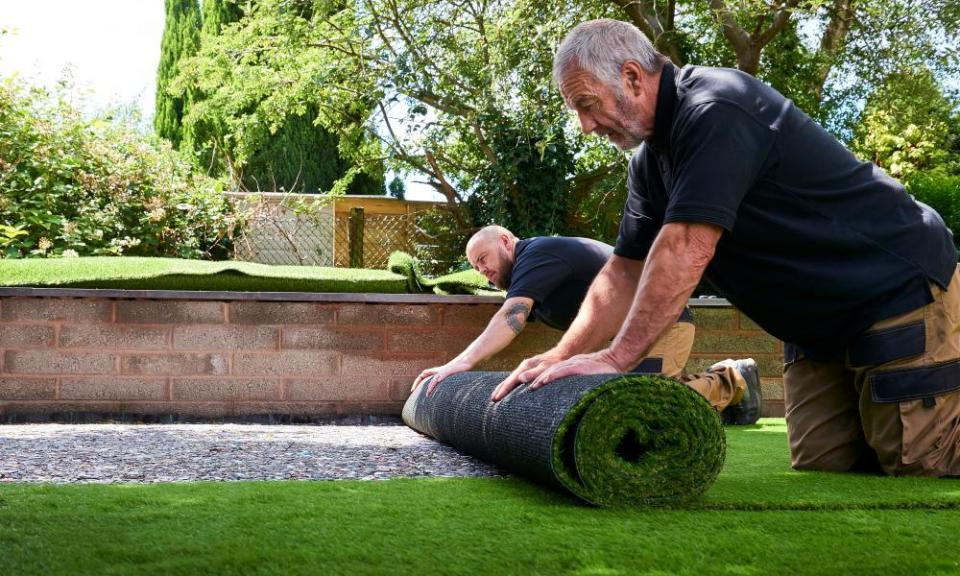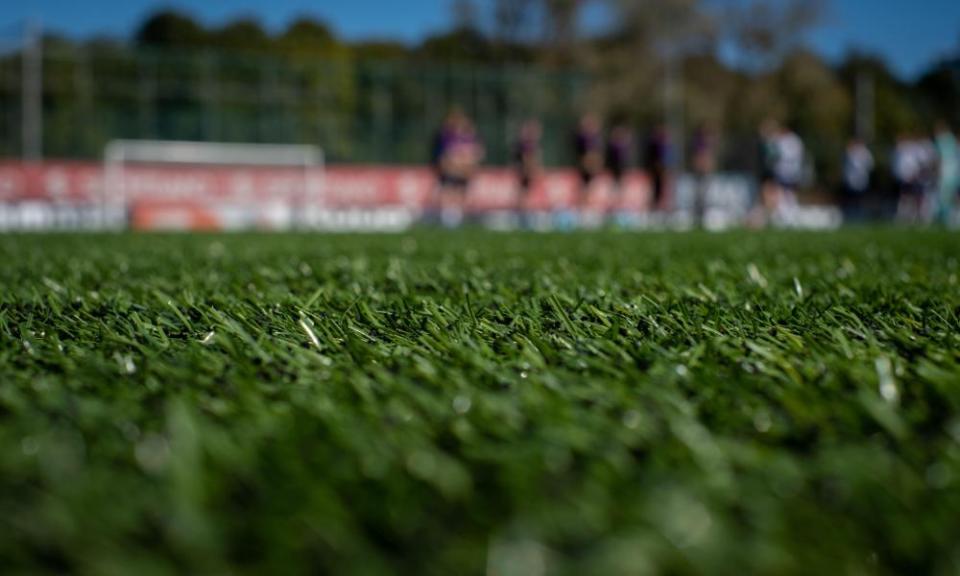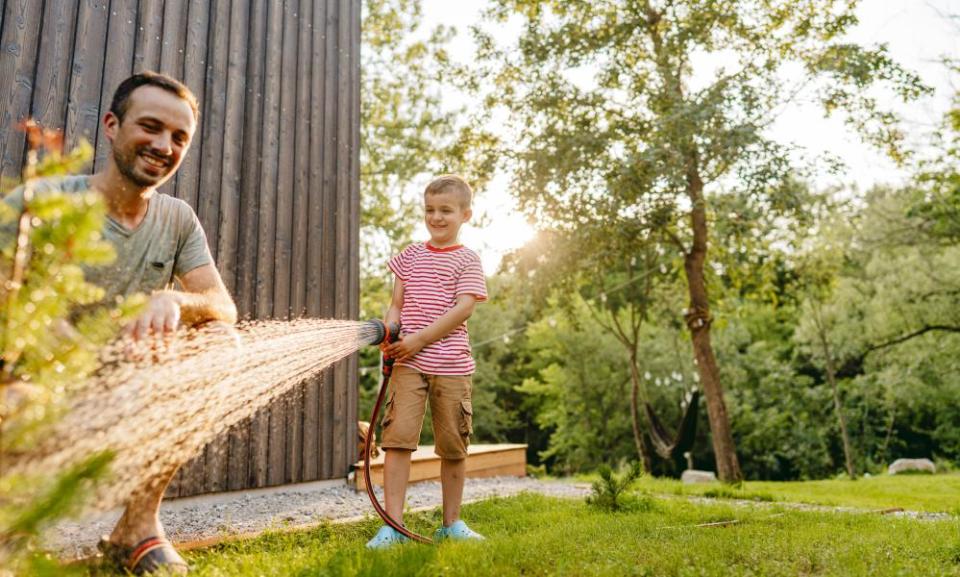‘It would survive nuclear Armageddon’: should plastic grass be banned?

My lawn is a disaster. To be honest, it’s not really a lawn at all. Any green is mostly moss, the rest is mud. More no man’s land than bowling green. The reasons for this are: small London garden (I know I am lucky to have one); not a lot of sun (stolen by the neighbour’s overhanging apple tree); two footballing boys (even though, now banned for life, they have to go to the park). And possibly also inexpertise on the part of the groundsman, though he has tried – I’ve turfed, and seeded, aerated, watered, fed, scarified, sung to it. I’m about ready to give up.
There is an obvious solution: artificial grass. Beautifully, uniformly verdant all year round, low maintenance, no mowing required, no mower required, no watering, no mud. I might even let the boys back on to it. Or not.
I’m not alone in thinking of faking it. A survey last year by Aviva found that 10% of UK homeowners with outside space had replaced at least some of their garden’s natural lawn with artificial grass, and a further 29% plan to or would consider making the swap. During the pandemic, when everyone was thinking about the outdoors, searches for “artificial grass” jumped 185% from May 2019 to 2020, according to Google Trends.
My own search finds dozens of firms offering artificial grass, seducing me with pictures of lawns that look like the green baize of snooker tables. And promises – no mud, no sweat, no tears. And no guilt either – here’s one that says it’s “better for the environment” – because you don’t have to water, mow or fertilise. Well, that’s a relief, though we’ll return to this later.
I might miss the smell of summer: freshly cut grass. What, I don’t have to? I can brush in artificial grass cleaner with that very fragrance? Happy days. Soon I have a quote for supply and installation, 40 sq metres of a mid-range product: £2,900 plus VAT. Ouch. But you can just buy the stuff for as little as £7 a sq metre – how hard can it be to DIY?
Artificial grass was invented by James M Faria and Robert T Wright at Monsanto and first installed on a recreation area of a school in Providence Rhode Island in 1964. It hit the headlines a couple of years later when it was laid in the Astrodome in Houston, Texas, and became known as AstroTurf.

Artificial turf for sport, now produced under different brand names by other companies, has become increasingly controversial, most seriously after being potentially linked to the deaths of six professional baseball players in Philadelphia, who had the same rare form of cancer. It often uses rubber granules from recycled tyres, which can contain heavy metals, benzene and other carcinogens. Artificial grass for domestic use and landscaping, which began to be a thing in the 1990s, is normally made from polypropylene or nylon (polyamide) and doesn’t often contain rubber granules. The global artificial turf market (including sports use and domestic use) grew 8.4% in the past year to $4.87 bn (£3.95bn) and is expected to reach $6.83 bn (£5.6bn) in 2027. No wonder so many companies want to put plastic over your garden.
Before I take the plunge, I ask Guardian readers to share their experiences of artificial lawns. Some are positive. Several, including Don in Fife and Wayne in Worcester, mention their dogs digging up the old grass. And Alex in Surrey’s greyhounds used to bring mud into the house. Not any more. As well as dogs, children come up. “It’s been wonderful, and the grandchildren love it,” says Charles in Berkshire. And when it comes to croquet, in-house knowledge of the small bumps and inconsistencies in the surface allows them “to win against all comers”. Home advantage – I like it.
It was brilliant to have a party on, people put their fags out on it and it was fine
Phil in Weston-super-Mare did it for his son to play football on – just a little bit in the goalmouth, “so it didn’t become a mud bath”. It was the same for Genevieve in Kent: her kids turned the garden into a quagmire, so they put down fake grass. “It was the most successful thing – they just played football all the time. It was brilliant to have a party on too – people put their fags out on it and it was fine. I think it would survive nuclear Armageddon.”
This was a while back, in the 00s, when her family were pioneers of artificial grass. They’ve moved house since then: “We wouldn’t get artificial grass now.” Not just because the kids have grown up. “Because of all the reasons we now know we shouldn’t have it.”
***
‘I can’t stand plastic grass!” bellows the naturalist Iolo Williams, who presents the BBC’s Springwatch, speaking from his home in mid-Wales. “It is hugely damaging to the environment on several levels. First of all it takes away the natural habitat from a whole host of species, notably invertebrates like earthworms, valuable in their own right but also a valuable food source for all kinds of birds and mammals.”
Last year’s WWF Living Planet Report found that globally, wildlife populations have plunged by 69% over the past 50 years, with the UK one of the most nature-depleted countries in Europe. This is not the time to be destroying natural habitats and breaking up food chains.
“If you want to see blackbirds and song thrushes, you’ve got to have grass full of invertebrates,” says Williams. “People are lamenting the decline of a lot of these birds, but if you stick down plastic grass, what do you expect? You reap what you sow. I would love to see plastic grass banned once and for all. It makes me very angry. I absolutely detest it.”
Lynne Marcus, co-chair of the Society of Garden Designers, also underlines the fact that artificial lawns are no-go zones for wildlife. “People may say butterflies or bees can land around it, on the strips of soil we have with a few plants, but it’s like if you put a motorway down the middle of a forest. The animals can’t get from one side to the other to procreate.”
With support from the Royal Horticultural Society and the Landscape Institute, the society has launched a campaign on this issue. It wants people to say no to fake grass. The charge sheet is a long one: artificial lawns destroy natural habitats and soil; they contribute to carbon emissions during manufacture and transport, whereas real grass absorbs CO2; they overheat in the summer and contribute to urban heat islands; they cause flooding as they absorb less than 50% of the rain that falls on them; they pollute waterways, as over time the plastic breaks down into microplastics, which is washed into our drainage and discharged into rivers and the sea; they are neither biodegradable nor recyclable, and after their life cycle (typically up to about 15 years) they go into landfill where they will continue to pollute.
In short, they are an environmental nightmare, green in colour only. “Every time you put one down, you’re saying: ‘I know we’re all worried about climate change, but guess what, I’m going to contribute to it,’” says Marcus, before adding that she doesn’t want to blame people. “It’s about public engagement with the issue, informing and educating.”
She rejects any idea that they are maintenance-free, explaining that over time they accumulate a buildup of excrement and urine from birds, mice, foxes, cats and dogs, and have to be regularly cleaned and disinfected.
You can’t get a plastic bag, yet you can cover your garden in plastic. It seems to me there should be something illegal about that
“You can’t get a plastic bag, yet you can cover your garden in plastic,” says Marcus. “It seems to me there should be something illegal about that.” And she thinks that in years to come we’ll look back at it in the same way as we now look back at driving without seatbelts or smoking next to babies. “Oh my God, can you believe it, we used to lay plastic lawns!”
The tide does seem to be turning. The Chelsea Flower show banned fake grass last year. Ed Horne of the RHS, which runs the event, said: “Fake grass is just not in line with our ethos and views on plastic. We recommend using real grass because of its environmental benefits, which include supporting wildlife, mitigating flooding and cooling the environment.” The housing secretary Michael Gove plans to prevent developers from laying fake grass in new housing schemes.
The mood is reflected in some more of our reader responses. In Somerset, JP put down a plastic lawn because it was a tiny patch and grass wouldn’t grow. “Within months it started stinking of urine due to the dog toileting on it. About six months ago we’d had enough and I ripped it out. I regret the waste of plastic. We now have a sedum lawn, which loves poor soil and is fantastic for pollinators. I wish we’d done that all along.”
In South Ayrshire, Dennis inherited a plastic lawn when they moved to their place. “It was filthy, and had faded to a light insipid green.” So they removed it, and the gravel underneath, imported topsoil and compost, and planted butterfly- and bee-friendly shrubs and flowers. “Our garden, lifeless before, is now full of life.”
Barbara Samitier, a French garden designer working in London, thinks that the need for a perfect green lawn may be a peculiarly British thing. “You can’t imagine a garden without it. I think it belongs to the kind of imagery maybe from cricket, Wimbledon, this green and pleasant land. It’s what people in this country have been raised to see as nature.”
There are alternatives that aren’t plastic, even if you have a small, north-facing city garden and children. “You can do a little woodland, make it more a sort of exploratory playground. A family garden doesn’t need to be about an expanse of lawn – there are different ways to engage children outdoors.”

Even if you have a lawn, it doesn’t have to look like Centre Court on the opening day of Wimbledon. “If I look at a perfect lawn, it doesn’t make me feel relaxed,” says Samitier. “I’m thinking it uses a lot of water, requires a lot of cutting, also chemicals to keep it weed-free and to keep it going in spite of the changes in weather. Whereas if I look at a less perfect lawn with maybe some long grass, areas that haven’t been mown, I know there is a lot of life in there, insects and pollinators. For me, that looks a lot more beautiful.”
It’s about accepting the seasons. “It doesn’t have to be perfect all the time, so in the winter it gets muddy, in the summer it’s dry but that’s fine: it comes back when it rains. I think in England a lot of gardens are about ego and controlling, making everything do exactly what you want, the grass needs to be perfect and all of this. But now we see the beauty of letting go a bit and accepting we don’t have to control everything.”
Artificial grass makes Samitier’s heart sink. “Don’t do it! You’ll regret it,” she warns me.
But it’s OK, because I’m already moving away from plasticking over my scruffy little urban patch and trying to see it in a new light. Not mud and mess, but life and beauty … well, let’s not carried away. Not no man’s land, though, nor no beast’s land. There is birdsong. And right on cue, almost as if it was paid, a dunnock shuffles on to my not-lawn and starts hopping around, hunting for breakfast.

